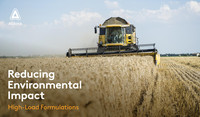
Why are growth regulators important in cotton growing?

Defoliation also reduces the amount of trash contamination in the lint and a cleaner final product post-ginning, giving the grower a better-quality product for the marketplace. A further benefit is that the defoliant accelerates boll opening. This action cuts the time the crop is left standing prior to harvest so reducing the risk of exposure to bad weather, pests or diseases. It also means more bolls open in time for harvest which helps maximize yields in any given hectare of cotton produced.
How do they work?
All defoliants have a common mode of action in that they alter the balance of hormones in the plant. Adama offers defoliant solutions globally and in our Cotton focus we are currently zooming in on Adama Australia with three main cotton defoliants for use at harvest.
These are:
- Escalate 500 – 500 g/l thidiazuron - for leaf drop/defoliation prior to harvest. The product of choice when conditions are warm to hot (+25°c).
- Escalate UltraMax – 240g/l thidiazuron + 120 g/l Diuron. For leaf drop/defoliation prior to harvest. The product of choice when conditions are cool to warm for example when night-time temperatures dropping to or below 12°c.
- Promote Plus – 900 g/l ethephon. For acceleration of boll opening.
Escalate 500 and Escalate UltraMax both mimic hormones called cytokinins. When applied to cotton they stimulate a huge increase in ethylene synthesis. This increase alters the balance of hormones in the leaf which in turn triggers it to separate from the plant at the base of the petiole. An area known as the abscission zone.
The formation of the abscission does not always ensure leaf drop. This is because the vascular bundles that pipe water and nutrients in and out of the leaf are not separated by the abscission zone. It usually takes a little wind to break theses vascular strands and cause leaves to drop.
Promote Plus, directly releases ethylene in the plant stimulating abscission in boll walls, causing them to open sooner. While it is known and used as a boll opener the increase in ethylene in the leaf also assists in leaf abscission as well.
It should be noted that all the defoliants rely on plant processes for effective defoliation to occur so the effectiveness of defoliation relies heavily on the crop itself. Crops that have soil moisture available and high nitrogen levels tend to be more difficult to defoliate. Temperature also has a major effect with defoliation being easier and requiring lower rates under warm to hot weather conditions.
What are cotton farmers likely to see happen if they get the PGR and defoliant timing wrong?
If defoliation occurs prior to the crop reaching maturity this can have a negative impact on reducing both yield and quality. In particular Micronaire, the measure of the air permeability of compressed cotton fibres.
Using rates that are too low or applying products outside the required temperature range can lead to poor levels of leaf drop. This will delay the time before effective harvest can occur and lead to the need for additional defoliation passes which is both costly and time consuming.
Excessive defoliant application rates particularly from Escalate UltraMax and Promote Plus can cause leaves to die/desiccate on the cotton plant prior to the abscission forming at the abscission zone. This results in ‘leaf freezing’ (see photo) with leaves being held on the plant. This is undesirable as it causes an increase in the amount of trash being picked with the lint. Excessive increased trash can potentially increase ginning costs and reduce the product’s market value.
When should they be used and why is the timing crucial?
There are a number of different methods that can be used to determine when the crop is ready for defoliation.
- Boll cutting – This is the easiest and preferred way of determining maturity. Bolls are mature when they become difficult to cut with a knife, the seed coat has turned brown and the seed itself is well-developed and solid, not gelatinous.
- Percentage bolls open – Crops can be safely defoliated when 60-65% of the bolls are open.
- Nodes above cracked boll – Usually four nodes above cracked boll will coincide with 60-65% bolls open.
Weather conditions, particularly temperature, will affect the plant’s ability to defoliate. Hot to warm conditions will usually see the most effective and rapid defoliation. When conditions became cooler the use of Escalate 500 will become ineffective and growers will need to switch to Escalate UltraMax to attain suitable leaf drop.
Even when UltraMax is used under cool to cold conditions leaf drop and boll opening will be slower. Usage rates of Escalate and Escalate UltraMax are in part chosen based on weather conditions at the time with lower rates effective at higher temperatures. In cooler growing climates some later-maturing bolls may need to be forgone to allow the crop to be effectively defoliated before the onset of cold to very cold conditions.
What is a typical application regime?
For irrigated crops a typical defoliation programme would budget for three applications to achieve effective defoliation and boll opening. In the past, defoliation was usually completed in two passes. However, as crops have become bigger - with significantly higher yields, higher nitrogen rates and the advent of round bale pickers - growers should budget for a three-pass programme.
First Pass: the first pass should generally focus on removing as much leaf as possible. Depending on the temperature, Escalate or Escalate UltraMax, should be used at robust rates with only a small rate of Promote Plus - less than 800 ml/ha. Avoid using higher rates of Promote in the first pass as this may result in an increase in leaf freeze. Higher water volumes at application are also desirable to maximize coverage.
Second/Third Pass: the second and third pass will partly, depend on the effectiveness of the first pass. The main difference will be the use rates of Escalate/Escalate UltraMax and Promote Plus. Generally, the usage rate of Promote Plus in the second and third pass will be significantly increased to assist in boll opening where required. Leaf drop will also be required as the mid canopy would have obtained limited coverage of Escalate/Escalate UltraMax in the first pass.
As a note of caution, be wary of using ground rigs at defoliation. If not used throughout the season ground-rigs can cause significant damage to rows where the wheels pass. The damage caused can exceed the cost of an aerial application to do the same job.
What environmental/good practice measures are there?
One of the key environmental or good practice measures is to avoid having the crop actively growing at the time of defoliation. Two of the key planning decisions for this are effective nitrogen budgeting and soil moisture levels. High soil nitrogen levels at defoliation will usually inhibit cotton leaf drop and the aim should be to have soil moisture levels at the time of defoliation at refill point. This will assist effective defoliation, limit regrowth issues and assist in minimizing soil compaction issues at harvest.
To learn more on Adama's defoliants, please go to our countries' websites.



